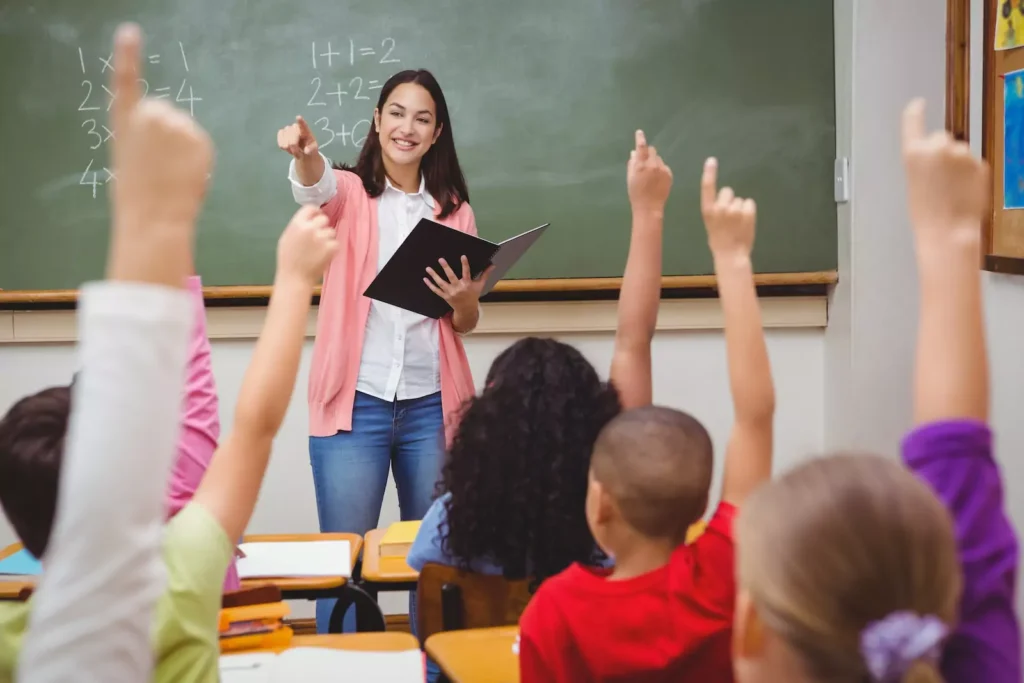Learn by teaching other people
Teaching-by-teaching is a powerful learning method that involves encouraging your child to explain what they have learned to someone else, whether it’s a parent, a friend, or even… a stuffed animal. By teaching someone else, or something else, your child reinforces their understanding of the subject, as they have to clarify their ideas and express them clearly and concisely. This stimulates his critical thinking and develops his communication skills. You’ll be surprised how much this approach can make learning easier for any child, deepening their knowledge and building their confidence.

Role-playing and scenarios
Children love to play, so why not incorporate learning into their games?
Role-playing games and scenarios are fantastic tools for illustrating complex concepts in an engaging and fun way. For example, if your child is studying history, organize a role-playing game where they step into the shoes of a historical figure and relive important events. Not only will this help him better understand the story, but it also promotes the development of his social and emotional skills. Let his imagination run wild and watch him learn while having fun. A technical term used to describe the integration of games into learning is called gamification.
The spaced repetition technique
This learning technique is also called by one of our coaches, the “study sandwich. The Essentials of Academic Success: Transitioning from Average Student to Undergraduate. Repetition is an essential ingredient in consolidating long-term memory. And how it’s done can make all the difference. The spaced repetition technique involves regularly reviewing learned material at increasingly longer intervals of time. Rather than revising intensely for a short period of time, encourage your child to regularly review the topics studied. This will allow him to better assimilate information and more easily remember what he has learned.
Active learning techniques
Active learning is about actively involving your child in their learning process. According to Edgar Dale’s learning pyramid, active learning techniques, such as demonstrations and practice, significantly improve retention compared to passive learning techniques, such as lectures and reading. Learning Pyramid – The Essentials for Successful Studies. So, encourage your child to ask questions, conduct their research, and actively participate in class. When he is active in his learning, he develops his ability to think critically and solve problems. You can also organize family discussions on interesting topics to stimulate their curious mind. By being proactive in their learning, your child acquires essential skills for success in school and in all areas of their life.
Understanding rather than memorization
It’s essential to encourage your child to go beyond simply memorizing facts. Encourage them to ask questions about the “why” behind the information they’re learning. Connect new concepts to pre-existing knowledge to facilitate understanding. When a child truly understands the topics, they will be able to apply them creatively in different situations, rather than simply repeating information mechanically.
Multisensory learning techniques
Every child has a learning style that they prefer or that suits them best. Some learn best by listening, others by reading or viewing information, while others need hands-on activities to fully understand. You need to combine tactile and kinesthetic approaches with visual and auditory approaches to strengthen and improve your child’s reading skills. Encourage your child to use different effective learning methods such as listening to educational podcasts, reading books, watching videos, and participating in hands-on experiments. This multisensory approach to learning strengthens information retention by engaging different learning channels in the brain. Feel free to adapt these learning techniques to suit your child’s unique interests and needs, as personalizing their learning is how you can maximize their potential.
Tips to support your child’s learning at home
Create a stimulating learning environment
Set up a dedicated study space in a quiet, well-lit area. Limit distractions, such as electronic devices, during study sessions. An environment conducive to concentration promotes your child’s productivity and focus on their studies.
Encourage curiosity through books (rather than Wi-Fi)
Foster your child’s thirst for knowledge by providing them with interesting books, educational toys, and enriching activities. When they’re curious, they’re more likely to explore new topics and learn independently.
Provide constructive feedback
When correcting your child’s mistakes, focus on the potential for improvement rather than the mistakes made. Celebrate their progress and encourage them to continue learning and improving. A positive and caring environment encourages your child’s confidence and self-esteem.
Establish a learning routine
Create a work routine and a regular schedule for learning, including regular breaks. A routine helps reinforce discipline and keeps your child motivated to study regularly. Invest time and energy in his education, and you will be rewarded with the remarkable progress he will make.
Conclusion
By using these effective learning techniques and adopting tips to support your child’s learning at home, you can truly open the doors to academic and personal success for them. Learning through teaching, role-playing and simulation, spaced repetition, active learning, comprehension, and multi-sensory learning methods are valuable tools that promote a child’s intellectual growth and development. So, start putting these effective learning techniques into practice today and support your child on this exciting journey of knowledge and achievement.

